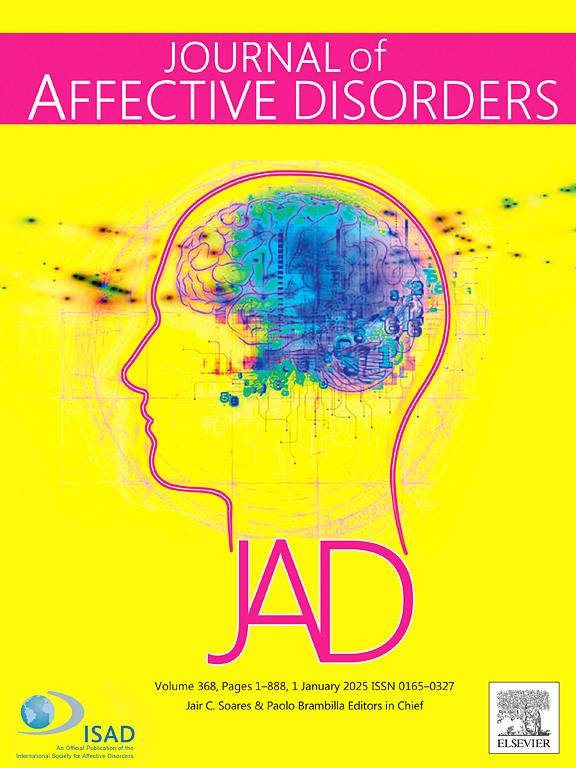电痉挛疗法与静脉注射氯胺酮治疗重度抑郁发作的疗效比较。
IF 4.9
2区 医学
Q1 CLINICAL NEUROLOGY
引用次数: 0
摘要
背景:电痉挛疗法(ECT)和静脉注射氯胺酮(IV)是治疗重度抑郁症和/或难治性抑郁症(TRD)的方法。电痉挛疗法被认为是治疗严重抑郁症最有效的方法之一,尽管在类似的TRD患者群体中,电痉挛疗法和静脉注射氯胺酮的有效性在该领域存在争议。方法:该回顾性图表回顾了来自精神病院的开放标签、非随机治疗,比较了长达三周的ECT和IV氯胺酮对重度抑郁发作(MDEs)患者的效果。我们的队列包括146名住院和门诊患者,年龄在18至74岁 之间。94例患者接受亚麻醉静脉注射氯胺酮,每周2次;52例患者接受ECT治疗,每周2 ~ 3次。主要结局指标为Montgomery-Asberg抑郁评定量表(MADRS)。结果:总体而言,在MADRS上,45.2% %的参与者在治疗开始与治疗结束之间表现出临床症状改变,而54.8% %没有。可靠变化指数(RCI)分析显示,58.9% %的患者症状有明显变化,41.1 %的患者症状无明显变化。卡方检验显示治疗类型与MADRS临床症状变化之间存在显著关联,接受ECT治疗的患者比接受氯胺酮治疗的患者表现出更大的症状改善(p )结论:与氯胺酮相比,ECT显示出更强的抗抑郁作用。需要随机比较试验来更好地了解这些模式。本文章由计算机程序翻译,如有差异,请以英文原文为准。
Comparing the effects of ECT and intravenous ketamine in psychiatric patients with major depressive episodes
Background
Electroconvulsive therapy (ECT) and intravenous (IV) ketamine are treatments used for severe depression and/or treatment-resistant depression (TRD). ECT is considered one of the most effective treatments for severe depression, although there is debate within the field regarding the effectiveness between ECT and IV ketamine in comparable TRD patient groups.
Methods
This retrospective chart review of open-label, nonrandomized treatment from a psychiatric hospital compared the effects of up to three weeks of ECT and IV ketamine in patients with major depressive episodes (MDEs). Our cohort included 146 inpatients and outpatients aged 18 to 74 years old. 94 patients received subanesthetic IV ketamine infusions 2 times a week, and 52 patients received ECT treatment 2–3 times a week. The primary outcome measure was the Montgomery-Asberg Depression Rating Scale (MADRS).
Results
Overall on the MADRS, 45.2 % of participants showed clinical symptom change between the beginning of treatment compared to the end of treatment, while 54.8 % did not. Reliable change index (RCI) analysis indicated 58.9 % showed significant symptom change, while 41.1 % did not. Chi-Square tests revealed significant associations between treatment type and clinical symptom change on the MADRS, with patients who received ECT showing greater symptom improvement compared to those who received ketamine (p < .05). Response rates of ECT and ketamine were 67.3 % and 45.7 %, respectively, whereas remission rates for ECT and ketamine were 60.0 % and 46.1 %, respectively.
Conclusions
ECT demonstrated the more robust antidepressant effects compared to ketamine. Randomized comparative trials are required to gain a better understanding of these modalities.
求助全文
通过发布文献求助,成功后即可免费获取论文全文。
去求助
来源期刊

Journal of affective disorders
医学-精神病学
CiteScore
10.90
自引率
6.10%
发文量
1319
审稿时长
9.3 weeks
期刊介绍:
The Journal of Affective Disorders publishes papers concerned with affective disorders in the widest sense: depression, mania, mood spectrum, emotions and personality, anxiety and stress. It is interdisciplinary and aims to bring together different approaches for a diverse readership. Top quality papers will be accepted dealing with any aspect of affective disorders, including neuroimaging, cognitive neurosciences, genetics, molecular biology, experimental and clinical neurosciences, pharmacology, neuroimmunoendocrinology, intervention and treatment trials.
 求助内容:
求助内容: 应助结果提醒方式:
应助结果提醒方式:


